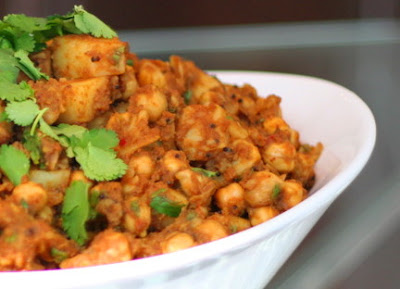

Growing up, we often served channa bateta (which literally translates as chickpeas and potatoes) with chevdo, a spicy snack mix, that added a lovely crunch and saltiness to balance out the soft and sour curry (a chevdo recipe will appear on this blog soon). Channa bateta is not a traditional curry that you eat for dinner with roti and rice, but in my mind, is associated with sunny weekend afternoons and family gatherings.
The distinctive flavor comes from tamarind (the name tamar-i-hind is Arabic for “date of India”), which is used extensively in Indian, Thai and Mexican food and is widely available throughout Asia and Latin America. The tree is native to East Africa and was known to the ancient Egyptians and Greeks.
The distinctive flavor comes from tamarind (the name tamar-i-hind is Arabic for “date of India”), which is used extensively in Indian, Thai and Mexican food and is widely available throughout Asia and Latin America. The tree is native to East Africa and was known to the ancient Egyptians and Greeks.

Tamarind fruit are irregular shaped brown pods, and they contain dark brown pulp which is often both sweet and sour (high in sugar, acid, vitamin B and calcium). It is used in both Worcestershire sauce (a key ingredient is Caesar salad and Bloody Marys) and HP sauce, presumably having come to British cuisine via the colonization of India. Tamarind is also traditionally used in the now wildly-popular pad thai noodle dish.
Unless you have regular access to an ethnic grocery store, you can easily order tamarind online. The various pastes have different concentrations, so proceed with caution. Too much tamarind can be a mouth puckering experience.
Serves 12 as a main dish and 24 as a side dish
Ingredients
4 lbs of red potatoes (about 6-8 large potatoes)
4 tablespoons canola or corn oil
1 tablespoon black mustard seeds
12-15 curry leaves (optional)
3 tablespoons chickpea flour (also known as gram or besan flour)
4-5 tablespoons of crushed tomatoes
1 tablespoon tomato puree (optional)
2 teaspoons salt
1 teaspoon red pepper flakes
1 teaspoon turmeric
1 teaspoon cumin
1 cup water (or more as required)
2 16-ounce cans of chickpeas, drained and rinsed
1 bunch of cilantro, de-stemmed and chopped
1-2 tablespoons concentrated tamarind paste or 1 cup tamarind and date chutney
1 lemon (optional)
Directions
1. Wash and peel potatoes. Cut into 1/2 inch cubes and boil until just soft. Cool to room temperature.
2. In a large pot, heat oil on medium. Add mustard seeds and curry leaves. When mustard seeds pop, add chickpea flour and cook until light pink (about 3 -5 minutes).
3. Add crushed and pureed tomatoes, salt, red pepper flakes, turmeric and cumin, and cook for 3-4 minutes.
4. Add 1/2 cup water to thin the tomato mixture. Add potatoes and chickpeas and mix well. Cook for 4 minutes and add up to another 1/2 cup water, or as much as needed.
5. Add half the cilantro and tamarind sauce and cook for a further four minutes. Tamarind sauces vary in potency and thickness. Use 1 or 2 tablespoons of pure tamarind sauce (which is thick and the color of molasses) or 1 cup of the tamarind and date sauce (which is sweeter, lighter and thinner). If you don’t know what you have, begin cautiously, and add to taste. If you add too much tamarind, you can use molasses or honey to balance out the sourness.
6. Add juice of one lemon for tartness.
7. Garnish with the remaining cilantro.
11 comments:
this looks very tasty.
Hope you are well.
Best,
Susan
Aly,
This is what I've been waiting for! So I'm going to choose a sunny
weekend in June and try this delicacy...
I will be sure to let you know. btw, I love tamarinds!
tx, aaron
Thanks Aly. I love tamarind. CKC
Wow, I read this over and it looks really good. Tamarind adds such a wonderful taste to dishes, but I have never had it in combination with chickpeas.
Thanks.
Nice one, Aly. I am salivating just reading about chana bateta
Nice one, Aly. I am salivating just reading about chana bateta
I have an echo!
I love this recipe but never knew about adding besan flour to it. I think we even made this together once at your place but I didn't remember about the flour. What a great way to thicken it -- I always end up heating things for ages to try to evaporate the excess liquid!
Another tamarind option is to use the pulp, which you can buy at Asian groceries too. Soak in a bit of water (warm is best), mash/squeeze thoroughly with your fingers, and strain into the dish. The concentrate is easier, of course, if it's available!
Hey if any of you in the Chicago area are going to make this, let me know. I have LOTS of extra tamarind to share.
Cheers,
AKR
Thanks for sharing this recipe.
Hello mate nicee post
Post a Comment